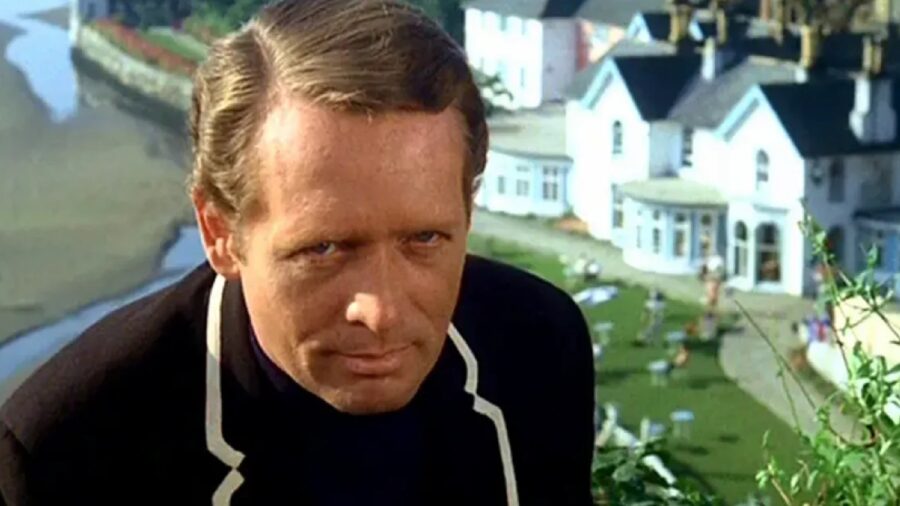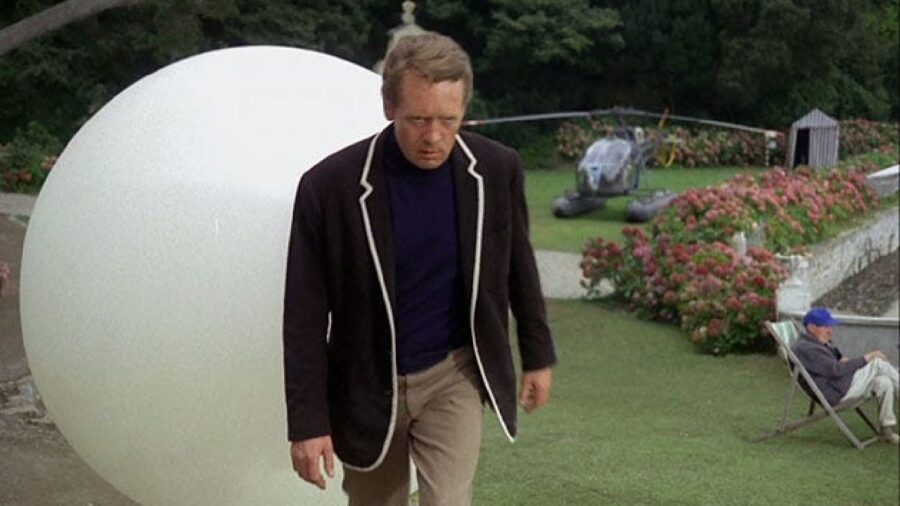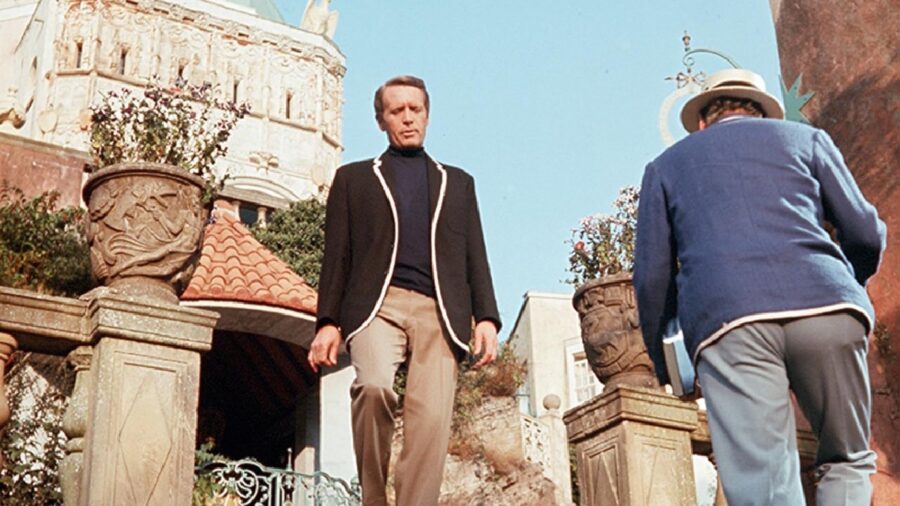
By Joshua Tyler
| Updated
Television was just beginning to experiment with big ideas in the 1960s. The Twilight Zone was going strong. The Outer Limits was hitting the next level, and Star Trek was taking the world where no one had gone before.
But no one had a BIGGER idea than Patrick McGoohan.
Fresh off the spy hit Danger Man, McGoohan was a bonafide UK star. So when Britain’s ITV gave him carte blanche to make his dream show, he delivered a total curveball: A psychedelic, dystopian anti-spy series where no one has a name, the beach is terrifying, and escape is impossible.
The show was called The Prisoner. And it’s either genius or a televised nervous breakdown. Maybe it’s both.
Why The Prisoner Failed
On the surface, The Prisoner is simple: A secret agent resigns, gets kidnapped, wakes up in a bizarre resort-like prison called The Village, and then spends every episode trying to escape or figure out who runs the place.
His name?
Number Six.
Their answer to every question he asks?
“You are Number Six.”
His weekly response?
“I am not a number, I am a free man!”
But the reality of The Prisoner is that no one was free. Not Number Six, not the people controlling him, and definitely not the cast and crew making the show.
Patrick McGoohan, Star and Creator of The Prisoner

Patrick McGoohan played Number Six, but he wasn’t just the show’s star.
He was The Prisoner’s co-creator, executive producer, director, and at times, writer.
McGoohan had one goal: use his spy show as a platform to wage war on conformity, surveillance, and an increasingly controlling modern society.
The network paying him to make the show, however, had very different goals.
Patrick McGoohan was hot off starring in the hit series Danger Man, and the network wanted more of that, only maybe a little weirder.
McGoohan gave them Kafka in technicolor.
From the start, The Prisoner was a power struggle, both on screen and off.
Episodes of The Prisoner Were A Debate

The television network wanted 26 episodes. McGoohan said the story needed only 7.
In theory Patrick and the network compromised on 17, but every episode produced after the seventh is a wild, insane rollercoaster of tonal whiplash, and that is almost certainly no accident.
One episode has mind control and assassination.
The next has an evil butler and cowboy duels.
At one point, Number Six runs for office.
Later, he switches bodies with a different actor.
At one point Six boxes a guy on the beach until someone plays “Pop Goes the Weasel.”
The Prisoner dared its audience to abandon the show and change the channel.
And all of that weirdness was NOTHING next to the finale.
Titled “Fall Out”, episode 17 finished up the show by breaking the entire audience.
After 16 episodes of questions and mysteries, it provided no answers. No real closure. Imagine how you felt after the Lost finale, and multiply it by ten.
Patrick McGoohan Went Into Hiding After The Prisoner Finale

Instead of giving the audience what it wanted, The Prisoner ended on a psychedelic courtroom trial, a man in a monkey mask, and a final twist that might be a metaphor… or might be total meaningless gibberish.
Fans were so confused and angry, that Patrick McGoohan briefly went into hiding.
That’s not a joke. He literally fled the country and hid out for a few days.
Imagine if Lost ended, and Damon Lindelof had to relocate to a bunker in Canada. We let that guy off waaay too easy.
Patrick McGoohan didn’t want to explain anything. Ever. He never told the cast what the show meant. He never told the network what the ending meant. He barely even told himself. He thought giving answers was a betrayal.
But The Prisoner’s viewers weren’t tuning in for a riddle wrapped in an enigma wearing a bowler hat. They wanted Cold War era spy drama. What they got was an existential hostage crisis starring an angry metaphysical philosopher.
Every week, there was a new Number Two. Sometimes charming. Sometimes terrifying. Sometimes it was Leo McKern in a bad wig.But the show’s real big bad, Number One? The chief villain behind everything?
You only see him once. In the finale.
The Real Number One

Spoiler: He’s Number Six himself.
Get it? He was his own jailer all along.
McGoohan thought it was profound.
It made no sense at all in the context of the plot.
Even if The Prisoner had made any sense, the audience would have been unable to decipher it because ITV aired the show out of order, at random times, in different regions.
Some viewers saw the finale before the pilot.
Others missed episodes entirely.
In the U.S., CBS aired only 16 of the 17 episodes.
It was like watching Inception with the reels scrambled.
The End of The Prisoner

After the finale aired, McGoohan left the UK for good. He moved to California and began working with Peter Falk, collaborating on episodes of Columbo.
McGoohan directed and wrote numerous episodes of the iconic detective show. He also guest-starred opposite Falk in four Columbo episodes with two of those appearances winning Emmy awards.
The collaboration between McGoohan and Falk was so iconic that there’s even a new book about their work together called In The Destructive Element Immerse: Peter Falk and Patrick McGoohan in Columbo-land.
But Patrick was never involved in anything as wild and ambitious as The Prisoner, again.
When it aired in 1967, The Prisoner drew modest ratings, but no blockbuster buzz. It ended with confusion, frustration, and a canceled second season. A second season, which, to be fair, Patrick McGoohan probably never intended to do anyway.
The Prisoner Failed But Ultimately Succeeded

It wasn’t until decades later—after DVDs, retrospectives, and conspiracy blogs—that The Prisoner was finally hailed as a masterpiece of counterculture television.
It’s since gone on to influence other creatives. If you’ve seen both The Prisoner and the aforementioned Lost, you probably noticed some very direct inspiration.
Shows like Twin Peaks, Severance, Black Mirror as well as movies like The Matrix and Inception all owe The Prisoner a debt of gratitude too.
For all its craziness, The Prisoner is now seen by most as a both brilliant and groundbreaking.
That’s especially true of the show’s first seven episodes. The only seven episodes Patrick McGoohan really wanted to make.
All seven episodes are a must-see for fans of the genre, but if we’re picking The Prisoner’s best effort, it’s the show’s fifth, titled “The Schizoid Man.”
By this point in the series, Number Six has been trapped in the village for a while. The various Number Twos who have appeared and disappeared, failed to extract any information from him.
So, the latest Number Two hatches the most diabolical and complicated plan yet: Convince Number Six he’s someone else.
A complex campaign of brainwashing begins, in which the masters of The Village work to make Number Six question his own identity. They tell him he’s Number Twelve, and even bring in a duplicate to replace him as Number Six.
The episode is an intense mind game with a lot to say about about the fragility of self-image and the tools of psychological manipulation.
And that’s true of every episode The Prisoner produced. They’re all trying to say something. Even the crazy terrible ones. Especially the crazy terrible ones.

Some do a better job of it than others, but McGoohan had a lot on his mind, and he used The Prisoner to say all of it.
Whether the audience wanted it, or not.
In the end, The Prisoner was a battle between a visionary and his audience.
The visionary won.
And then he ran away.







